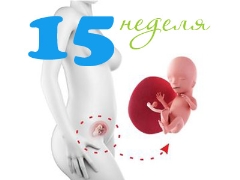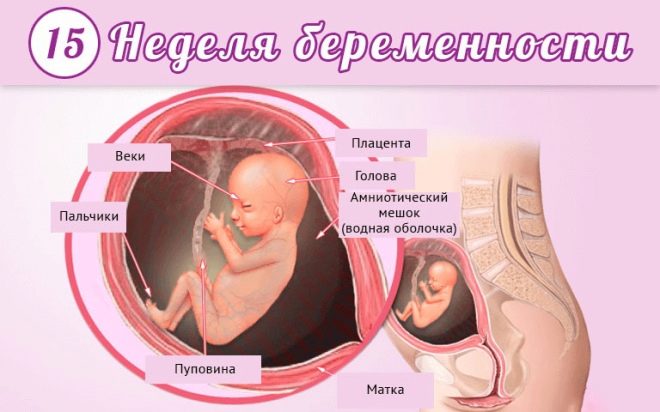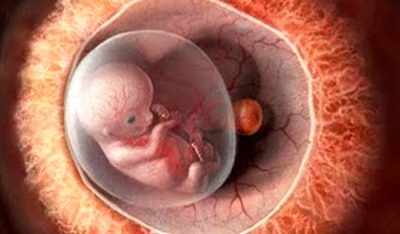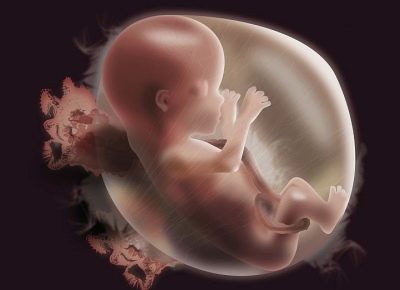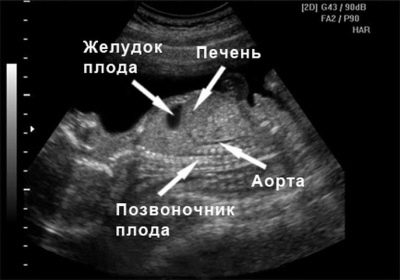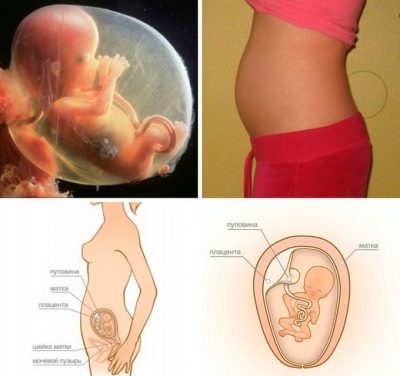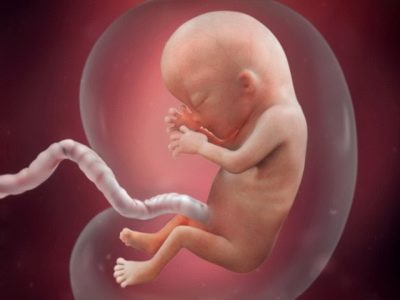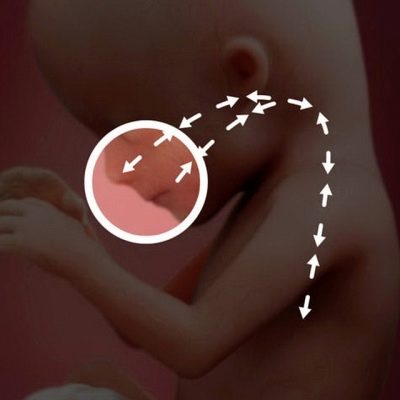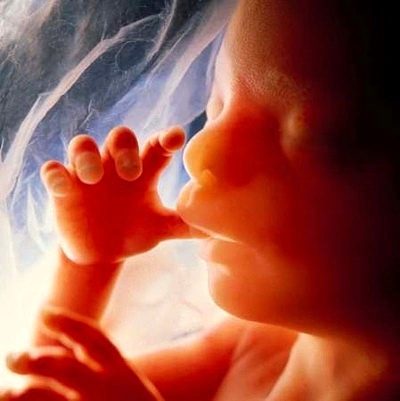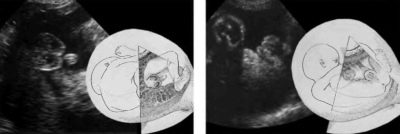Fetal development in the 15th week of pregnancy
Each new day of the baby’s life in mom’s tummy is accompanied by numerous changes that affect not only the baby’s appearance, but also its internal organs.
How does the fetus change?
15 week of pregnancy belongs to the second trimester - this is the time when numerous metamorphoses have already happened to the baby: the structure of his body has changed, the internal organs have activated their work.
Skin covering
The baby’s skin is still very thin, through which blood vessels are seen through well. Gradually, the structure of the skin layers changes. The active work of the heart of the child contributes to the fact that his skin becomes a bright pink shade. After some time, they will be more dense and acquire physiological color.
Heart and blood vessels
The baby’s cardiovascular system by the 14th to 15th obstetric week of pregnancy is already fairly well formed. For example, a child’s heart already beats, and, like adults, it already has four cameras. The baby's heart beats quite actively: the organ pumps about 25-28 liters of blood per day.
To assess the performance of the cardiovascular system of the baby, doctors use a special clinical criterion - heart rate (HR). It is measured, as a rule, during the ultrasound. The rate of this important indicator is presented in the table.
Heart rate | Heart rate |
Heart rate | 120-150 beats per minute |
Nervous system
The nervous system is actively developing in the baby’s body. Very important changes occur in the brain. The child is actively developing the bark - it is this that makes it possible to speak, think, perform any actions. The number of interneuronal connections between neurons (brain cells) is increasing every day. Grooves and gyrus appear in the cortex.
The active development of nerve analyzers leads to the fact that the baby has the first taste sensations. Experts note that babies are able to feel the taste of amniotic fluid in this period of their prenatal life. It largely depends on the food that the expectant mother consumes. Amniotic fluid can be salty, bitter or even sweet. In the child’s language, the taste buds are already present, which are necessary for recognizing different flavors.
A child in the 15th week of his intrauterine life begins to distinguish voices. At this time, doctors recommend that future parents start talking to their child, as this helps create a good psycho-emotional connection between them. In a pregnant woman at this time, as a rule, the first specific sensations begin to appear in the body.
The child’s blood already has specific hormones. For example, boys even have testosterone - the main male sex hormone.
Secretory organs
The sweat and sebaceous glands are already functioning in the baby at 14-15 obstetric weeks, their ducts are located in the skin. Some endocrine glands also work. For example, the thyroid gland begins to produce the first hormones. The pituitary gland is also activated.
Organs of the gastrointestinal tract
The baby already has a liver and gall bladder. Bile is also formed, which is the most important substance for digestion. She gets into the intestines of the baby, participating in the formation of the original cala - meconium. A full digestion will appear in a child only after his birth and after eating the first portion of mother's milk.
During this period of prenatal life, the baby already has an intestine. Its walls are even capable of cuts, which experts call peristalsis. Peristaltic movements of the intestine are enhanced when bile enters it. Villi are already formed on the intestinal walls, which are necessary for the absorption of nutrients.
Excretory system
By this time, the child’s prenatal life has already formed the kidneys and urinary tract elements. The baby can independently swallow the amniotic fluid. This fluid eventually ends up in the kidneys and is eliminated. This process is very important, as it is necessary for the full development of the urinary system. The baby at this stage of pregnancy is already able to urinate.
Many expectant mothers are worried that if a child's amniotic fluid is swallowed, the baby may choke. Panicking about this is not worth it, since the ingestion of the amniotic fluid is quite a physiological reaction necessary for the full development of the baby.
The active ingestion of amniotic fluid also contributes to the fact that the respiratory muscles of the fetus are being improved. In this process, the auxiliary participation is carried out by intercostal muscles. This process is also necessary for the improvement and further development of the respiratory system.
Lungs
The baby continues to develop lung tissue. By the time of birth, the lungs should be well formed. This is necessary so that the baby can take his first breath on his own. During this period, the child continues to form a bronchial trunk.
The larynx and the glottis are already formed. During intrauterine development, these voice-forming organs are in inactive respiration. For the first time they will work at the moment the baby is born.
Musculoskeletal system
The bones of the child are becoming more dense. Every day the bone structure changes. Numerous joints are already quite mobile. The kid begins to actively "study" his body - he bends and unbends the arms and legs, can turn over, open and close his mouth. Some babies begin to touch their faces with their fingers.
Active development of the nervous system and facial muscles contributes to the fact that the child has the first manifestations of emotions: the child can smile, grimace and even yawn.
Body parameters
The active development of the child contributes to the fact that the proportions of his body are changing: the baby’s legs become longer than the arms, and the child’s body is stretched to length.
The active growth of the baby helps to increase body size. To assess the intensity of intrauterine development, doctors use several basic clinical criteria. One of them are the weight and height of the baby. Normal values of these clinical indicators are presented in the table.
Estimated parameter | Norm at 15 weeks gestation |
Fetal growth | 10-11 cm |
Fruit weight | 70-80 gr |
Location
During pregnancy, the way the fetus is in the womb is also evaluated. It is important to note that the position of the baby at this time may not be entirely final - very active children may turn over several times and change their original position to the birth.
Evaluate how the fetus is located in the womb, using an ultrasound. The examiner can accurately determine the position of the fetus in the uterus. Incorrect is considered to be the transverse and oblique position of the child.
Baby look
At this stage of pregnancy, the baby looks quite “humanly”: his face is already formed, you can distinguish the forehead, nose and cheeks. Chin line is quite distinct. It is important to note that the final formation of facial contours will occur somewhat later.
Some babies at this period of intrauterine development appear brows and cilia - they are very small and subtle. They appear in the places where the hairs were growing before. Some experts believe that even by the color of cilia and eyebrows, you can assess what the child will be: dark or blonde.
The baby has already formed ears, which are still very soft in their density.
Is it possible to determine the gender?
At this stage of pregnancy, future parents can already know whether they are expecting a boy or a girl. In children, by the 15th week of their intrauterine life, gender signs are usually formed.
According to external sex characteristics, the ultrasound specialist can also sound the sex of the child.
It is important to remember that the definition of sex in the 15th week of pregnancy is not yet absolutely accurate, since the probability of errors in its determination and the notorious “human” factor in this case are quite high.
About what happens to the baby and mother in the 15th week of pregnancy, see the next video.
